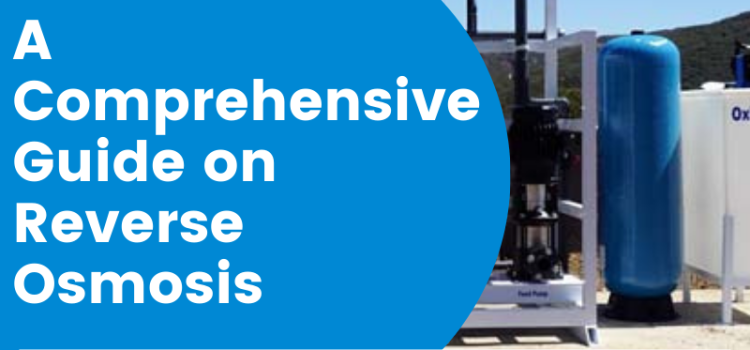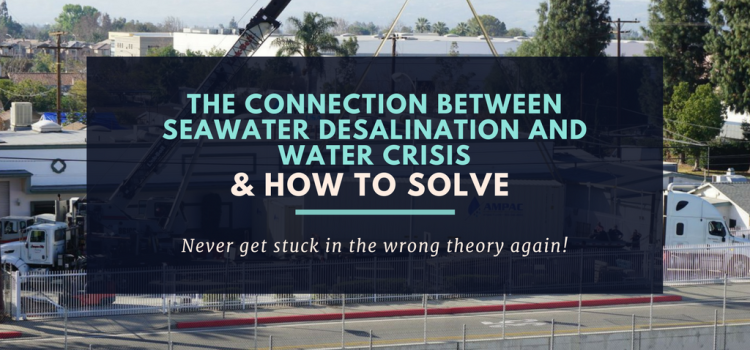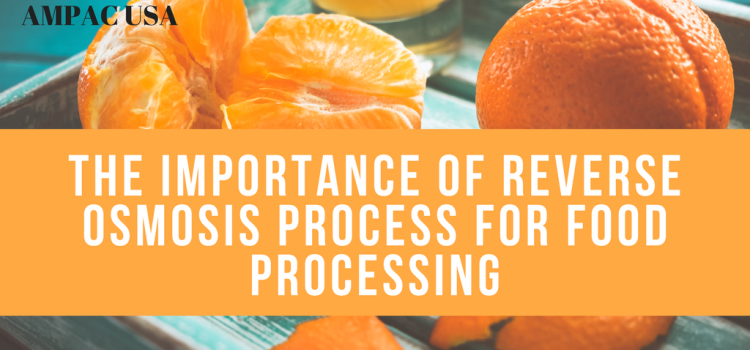A Comprehensive Guide on Reverse Osmosis-Ampac USA
Reverse osmosis technology has existed for many years, and it’s bound to exist in the future as well. If you have heard of this technology often and want to know it better, this comprehensive guide on reverse osmosis is exactly what you need. Here we have discussed different aspects of the RO technology and how you can make the most of it.
What is Reverse Osmosis?
Yes, we are starting with the basics. In essence, a reverse osmosis process in which water pressure is used to push water molecules through a very fine membrane ensures that all contaminants are effectively removed. The purified water with no contaminants gets to the permeate side of the membrane, and the water with concentrated contaminants is flushed out via the concentrate side.
How a Reverse Osmosis System Works?
An RO system usually has many stages that vary from 3 to even 10. A person needs to decide which stage water purifier they need as per the water quality in their vicinity. Usually, people go for a 4 or 5 stage RO filter only. The stages that come before the actual purification process are known as the pre-filtration stages. The stages after the water are purified are known as post-filtration stages.
Pre-Filtration Stages
The most common Pre-filtration stages are:
- Sediment Filter
In this stage, the suspended particles like dust, dirt, sand, and rust are removed. The coarse particulate and fine impurities are also removed to ensure that the carbon filter’s life is not shortened due to these.
- Carbon Filter
As the name suggests, this stage helps remove chlorine, odor, and color. It also eliminated organic impurities like health-harming pesticides. It can also absorb bad taste and organic compounds that often lead to bad taste.
The RO Membrane Stage
The most important water filtration stage is the RO membrane. When water passed through pre-filtration passes through the RO membrane, a thin, semi-permeable membrane with tiny holes, all the impurities are rejected. Only purified water with no impurities can pass this stage. The pressure created to pass the water through the RO membrane comes via a pump that pushes only high purity water through the membrane. It helps eliminate heavy metals, chemicals, dissolved salts, microbial contaminants, and pesticides on the membrane surface.
Reverse osmosis is vital for people/ entities that need to clean water with high TDS (total dissolved solids) levels of 300 ppm and heavy metals and chemicals like mercury, lead, chlorine, arsenic, fluoride, etc. It’s also recommended for those who want to eliminate microbial contaminants such as viruses, bacteria, cysts, protozoa, and other such contaminants.
Post-Filtration Stages
Usually, people prefer a reverse osmosis system that comes with just three post-filtration stages like a UV filter, a Post-RO carbon filter, and the remineralization stage.
- UV Filter
UV or ultraviolet filter offers a separate layer of purification in which the remaining microorganisms like viruses, bacteria, and parasites are eliminated effectively.
- Post RO Carbon Filter
This filter is the final filter in many RO systems. It helps filter water some more, polish it perfectly, and enhance water’s taste to ensure it’s totally colorless, odorless, and tasteless.
- Remineralization Stage
In this stage, the minerals that were stripped away from water, like calcium and magnesium, are added back to help make water healthier and tastier. This stage is optional.
Buying Guide on a Reverse Osmosis Filter- How to Choose a Perfect Option?
When a person wants to buy a reverse osmosis system, they often need help. Here’s a short and useful reverse osmosis buying guide that might help you.
- Purity
If the source water is brackish or contains heavy metals, dissolved minerals, heavy metals, nitrates, and radionucleotides that are hard to remove by using other methods. So, one should get the water quality tested to know the exact water purification needs.
- Water Waste
An RO water purifier often wastes water. Four or more gallons of water are wasted for every gallon that is purified. One solution to this problem is to fit the system with a permeate pump that might reduce the water waste by up to 80%. This option is suitable for people who are enthusiastic about preserving the environment.
- Type of Membrane
Two main options available these days are thin-film composite membrane or cellulose triacetate membrane. They are known as CTA, TFC, or TFM. The CTA membrane is ideal for those with high chlorine content in the water, while the TFC or TFM membranes are less susceptible to organic fouling. You can also explore saline water, brine water, and brackish water membranes if you need an RO system for commercial, industrial, or marine water needs.
- User-Friendliness
It is also a good idea to choose a user-friendly filter. If buying for a household, you should select a system that is easy to use by the person who must use it often. It should also be kid-friendly. In case you are buying for commercial or industrial purposes, make sure your employees can operate it easily.
- Installation
The installation of the reverse osmosis system should be easy and hassle-free. It would be good if you choose a manufacturer who can install the filter for you. The installation process should also not be too time-consuming and should be handled by experts who know what they are doing.
- Cost
When buying an RO system, you should calculate the cost per gallon of purified water. If the cost is low, it will mean that you start getting a return on investment earlier. If the cost is high, it might not give you value for money. So, calculate the per-gallon cost and be smart about where you invest your money.
- Support
The customer service of the company you are trusting should also be excellent. They should be able to answer all technical and non-technical questions about the product and must be able to resolve any issues quickly. It will also be good if the support team is available 24 by 7 as it will ensure you connect with them wherever in the world you are.
How to Maintain a Reverse Osmosis System?
Maintaining an RO system is an easy task if you know the basics. Here are some of the most common problems and their tried and tested solutions that will ensure your system lasts for a long and gives better value for money.
How Often Should Reverse Osmosis Filters be Changed?
It depends on what filter you are talking about. The pre-filter should be changed every 6 to 9 months. The carbon filter should also be changed every 6 to 9 months. As the RO membranes do most of the filtration, they are tough and can last for two to three years, depending on the vicinity’s usage and water conditions. The carbon filter that polishes the water also lasts for just 6 to 9 months only.
How Often Should I get the RO System Maintenance Done?
It would help if you got the basic maintenance done once every two months or once every four weeks. However, make sure you get a deep cleaning done as a part of the maintenance at least once a year. Doing so will ensure that you don’t require reactive maintenance and save a lot of money.
Who Should I Contact for RO Maintenance?
You can trust the manufacturer who supplied you with the reverse osmosis system to maintain it also. Or you can ask them for a recommendation and hire the person they recommend.
What If I Don’t Change the RO Filters?
If you fail to change the RO filters at regular intervals or when the alarm signals it, the filters will malfunction. First, the flow of the water will reduce, and then the water output would stop completely. So, it’s better to avoid that situation as it can lead to costly replacements.
How Long Should a Reverse Osmosis System Last?
Usually, a RO system should last ten to fifteen years. One should consider a replacement only when the manufacturer or the maintenance advises you to do the same.
Should I Go for a Water Softener?
A water softener can be added to the RO system if you think it’s needed, depending on the area’s water quality. People who live in areas with hard water often need a water softener. You can buy the water softener from the same manufacturer who has provided you with an RO system to ensure a perfect combination.
Where Should I Get the Parts for the RO System?
If you have bought a reverse osmosis system, make sure that you only buy the parts from the manufacturer. It will save you from the trouble of getting fake parts and wasting your money. As parts like membranes can be quite costly, always ask for the parts’ invoice and warranty. Also, make sure that the maintenance people add the parts rather than making it a DIY project. If you try to make it a DIY project, you might harm the entire RO system, and fixing it could cost you a lot.
What’s the Future of Reverse Osmosis?
As reverse osmosis is considered one of the most effective and useful water treatment technologies in today’s time, it can play a key role in the future. It is an effective way of solving the water crisis that’s impacting many nations across the globe. When coupled with seawater desalination, reverse osmosis technology can work wonders as more than 95% of the water present on the planet belongs to the sea and oceans. Reverse osmosis and seawater desalination allow us to use this water and help many situations like droughts or water shortages.
RO systems have improved continuously for the last few decades, and they continue to improve today. The research is ongoing to tackle water wastage problems and make RO technology more efficient, reliable, and sustainable.
Where to Buy a Reverse Osmosis System- Ampac USA?
AMPAC USA is the one-stop-shop for all water treatment needs as it excels in water treatment technologies like reverse osmosis, forward osmosis, seawater desalination. Customers from all over the globe trust us for Seawater Desalination Systems, SWRO Watermakers, Emergency Portable Watermakers, Marine Seawater Desalination Systems, Land-Based Watermakers, Offshore Watermakers, Military Seawater Desalination, Water Store Reverse Osmosis, Bottle Filling Stations, Water Vending Machines, Water Storage Tanks, Greensand Filter Regenerant, Scale & Corrosion Control, Water Neutralization, and Water Softener Cleaners.
We also specialize in providing commercial reverse osmosis purification systems that vary from 100~1200 GPD and 1,500~10,000 GPD. You can also trust us when you need help with Packaged Reverse Osmosis, Brackish Water Reverse Osmosis, and Commercial Water Filters. We also offer mobile and solar water treatment solutions by offering Portable Water Purification Systems, Mobile Water Treatment Systems, Solar Power Water Systems, and Mobile Water Provisioning Systems. Our experts also excel at designing, manufacturing, and delivering Industrial Reverse Osmosis Systems, Industrial Water Softeners, Industrial Water Filters, and ROWPU Military Water Purification Systems.
Customers also prefer us to buy Accessories and Consumables and meet high purity water needs like Type 1 Laboratory Water, USP Water, Type 1,2,3 Lab Water, Electro deionization Systems (EDI), and water quality monitor systems. Households trust our residential reverse osmosis systems like Reverse Osmosis Water Filtration Systems, Whole House Water Filters, Drinking Water Filters, Water Softeners & Conditioners, and Home UV Systems. We also help with wastewater treatment via products like Dynamic Sequencing Reactor (SBR), Grey Water Treatment Systems, Membrane Bio-Reactor (MBR), and Crude Oil Separation Systems. You can also trust us when you need bottle-free water coolers and water dispensers to start your own business and help the community.
Most of the systems we design, engineer, manufacture, quality test, and deploy are customizable and can be customized as per the needs of the clients. To know how we handle that process or inquire about any of the products we offer, connect with AMPAC USA. Our experts will first ask about your water purification needs and then provide you with the right solution that meets your expectations and fits your budget too. Call us on 909-548-4900 today or visit us here!
References:
https://www.cleanandclearwater.com.au/blog/why-reverse-osmosis-is-the-future-of-the-water-industry/
http://blog.watertech.com/how-to-maintain-a-reverse-osmosis-system/
http://www.advancedwaterfilters.com/buying-guide-reverse-osmosis-systems/
https://www.pureitwater.com/IN/waterandhealth/here-is-your-guide-to-understanding-how-an-ro-reverse-osmosis-water-purifier-works
https://www.espwaterproducts.com/blog/how-to-maintain-your-ro-system-for-best-performance/
https://www.ampac1.com/










